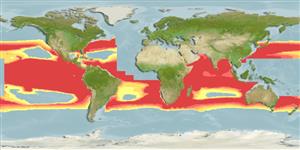>
Lampriformes (Velifers, tube-eyes and ribbonfishes) >
Lophotidae (Crestfishes)
Etymology: Eumecichthys: Greek, eumekes = very larg or long (Ref. 45335).
More on author: Günther.
Environment: milieu / climate zone / depth range / distribution range
Écologie
marin bathypélagique. Deep-water
Probably worldwide. Western Atlantic: southeastern Florida in USA. Southeast Atlantic: False Bay, South Africa (Ref. 4165). Northwest Pacific: Japan (Ref. 559). Eastern Central Pacific: Hawaii and Mexico (Ref. 4165). Indian Ocean: India (Ref. 4165).
Taille / Poids / Âge
Maturity: Lm ? range ? - ? cm
Max length : 150 cm TL mâle / non sexé; (Ref. 7251)
Description synthétique
Morphologie | Morphométrie
Épines dorsales (Total): 0; Épines anales 0; Rayons mous anaux: 5 - 9. Head and body silvery in color with 24-60 dark sub vertical bands; dorsal and caudal fins crimson in color (Ref. 4165). Dorsal fin with 310-392 soft rays.
A rare (Ref. 4165), mesopelagic species found at 1,000 m depth (Ref. 5213).
Life cycle and mating behavior
Maturité | Reproduction | Frai | Œufs | Fécondité | Larves
Heemstra, P.C., 1986. Lophotidae. p. 402-403. In M.M. Smith and P.C. Heemstra (eds.) Smiths' sea fishes. Springer-Verlag, Berlin. (Ref. 4165)
Statut dans la liste rouge de l'IUCN (Ref. 130435)
Menace pour l'homme
Harmless
Utilisations par l'homme
Plus d'informations
Taille/ÂgeCroissanceLongueur-poidsLongueur-longueurFréquences de longueursMorphométrieMorphologieLarvesDynamique des populations larvairesRecrutementAbondanceBRUVS
RéférencesAquacultureProfil d'aquacultureSouchesGénétiqueElectrophoresesHéritabilitéPathologiesTraitementNutrientsMass conversion
CollaborateursImagesStamps, Coins Misc.SonsCiguateraVitesseType de nageSurface branchialeOtolithesCerveauxVision
Outils
Articles particuliers
Télécharger en XML
Sources Internet
Estimates based on models
Preferred temperature (Ref.
123201): 7.7 - 15.1, mean 10.6 °C (based on 338 cells).
Phylogenetic diversity index (Ref.
82804): PD
50 = 1.0625 [Uniqueness, from 0.5 = low to 2.0 = high].
Bayesian length-weight: a=0.00115 (0.00043 - 0.00304), b=3.06 (2.83 - 3.29), in cm total length, based on LWR estimates for this (Sub)family-body shape (Ref.
93245).
Niveau trophique (Ref.
69278): 4.1 ±0.6 se; based on size and trophs of closest relatives
Fishing Vulnerability (Ref.
59153): Very high vulnerability (90 of 100).
